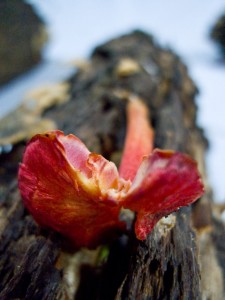A few weeks ago, I found myself standing alone on a damp, narrow, forest path with honeybees swirling angrily around me. The tally of stings on my legs and hands was growing quickly.
 It was the fourth day of Food Security Solutions, a farmer training event organized by Sustainable Harvest® in Matagalpa, Nicaragua, and I had come to this forest to visit beehives as part of the beekeeping workshop. From where I stood on the path, I could make out my fellow workshop participants in a clearing up ahead, listening intently to the trainers talk about hive maintenance and honeycomb harvesting. Minutes earlier, some bees had swarmed around me, and the singular layer of denim I had worn did not protect me from stings. I had retreated into the woods for a few minutes of respite.
It was the fourth day of Food Security Solutions, a farmer training event organized by Sustainable Harvest® in Matagalpa, Nicaragua, and I had come to this forest to visit beehives as part of the beekeeping workshop. From where I stood on the path, I could make out my fellow workshop participants in a clearing up ahead, listening intently to the trainers talk about hive maintenance and honeycomb harvesting. Minutes earlier, some bees had swarmed around me, and the singular layer of denim I had worn did not protect me from stings. I had retreated into the woods for a few minutes of respite.
Despite the constant hum and all-too-often prick coming from the bees that had followed me into the woods, I was not thinking about bees or pain. I was thinking about mushrooms. My train of thought stemmed from a simple question posed on the first day of the event, one that has stuck with me ever since:
What is the best way to utilize the resources we have at our fingertips?
Recognizing the value of the resources around us was a pervasive theme at Food Security Solutions, the four-day event which gathered together representatives from coffee cooperatives, NGOs, finance institutions, and development organizations together to learn innovative ways to tackle food insecurity in coffee communities. How can coffee growers with few resources see new potential in what they already have on their farms? How can they use those resources in different or better ways to reduce their families’ hunger? A final cup of brewed coffee represents a small percent of the tree that farmers work so hard to nurture — what are other ways to use the rest of the plant?
Throughout the event, I noticed participants and trainers answering these questions. I saw plump, delicious oyster mushrooms grown out of coffee pulp, a harvest byproduct which normally piles up unused on farms. I saw everything from riverbed rocks to molasses to leftover eggshells from the morning’s breakfast thrown into the mix during a lesson on the production of organic fertilizers; the idea being that effective fertilizer can be made using many resources already available on the farm. I saw bees carefully tended to, producing honey for consumption and sale.
These sights are why, in the midst of a harrowing swarm of bees on a forest path, I was peering at a decaying log, studying the clump of mushrooms growing out of it. I widened my gaze and pondered how the leaves and moss scattered around me could be harnessed in a healthy, sustainable way to improve the livelihoods of the people living in the area.
Today I am far from that forest path in Nicaragua; my bee stings are healed. The Food Security Solutions participants have all returned to their homes throughout Central America, bringing with them new skills to teach and projects to implement. And while I don’t live on a farm, I find that the idea of utilizing resources to their fullest potential often applies in a much broader context. To me, Sustainable Harvest’s® relationships with coffee cooperatives, finance institutions, development foundations, and NGOs are resources at our fingertips. Bringing these heads together to share ideas and tackle the critical issue of food insecurity in coffee communities is our best idea for a new and effective way to utilize this network.



.png)
